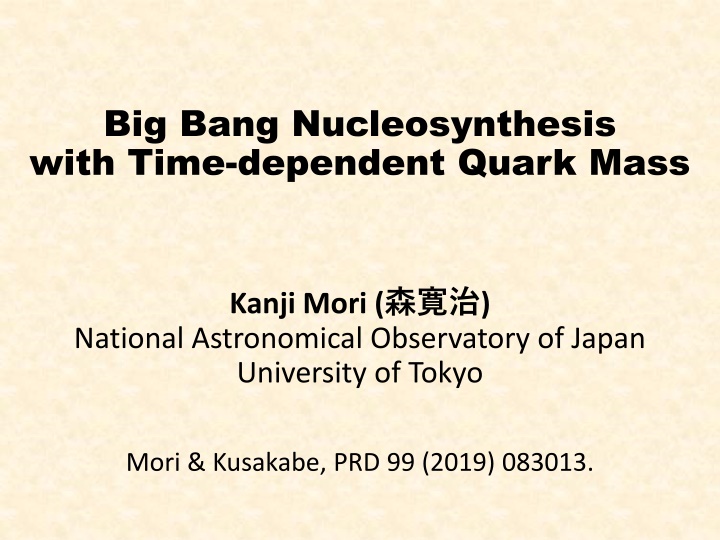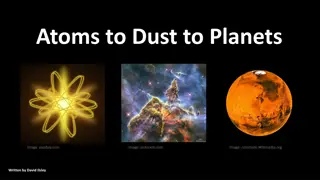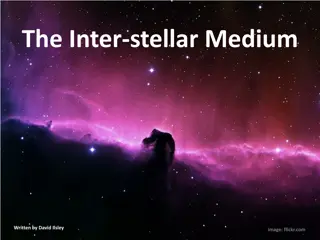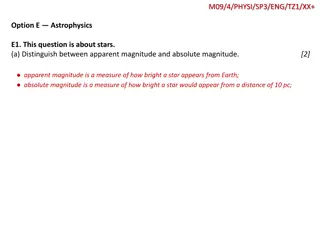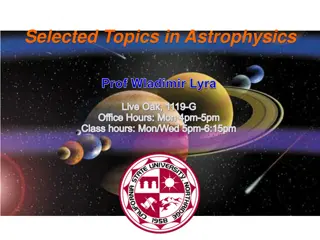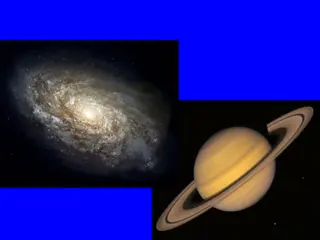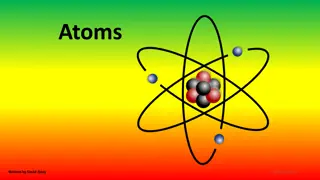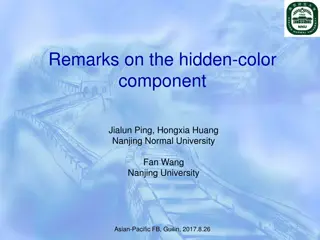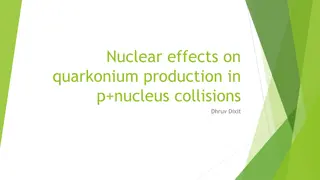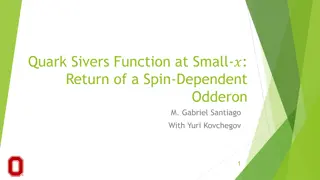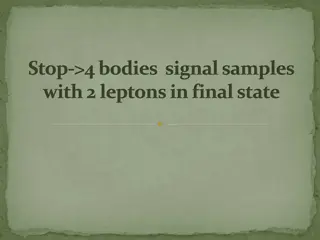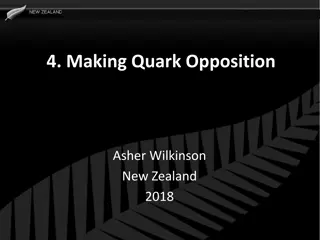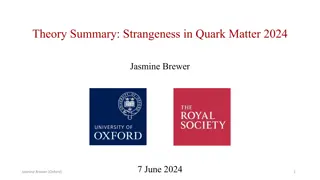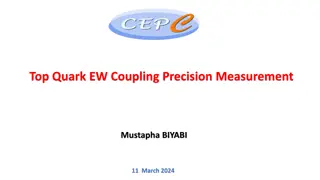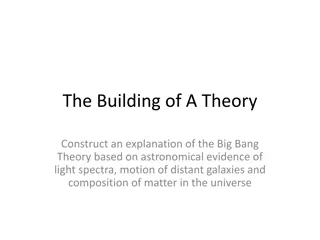Big Bang Nucleosynthesis and Time-dependent Quark Mass
Investigating Big Bang Nucleosynthesis and the implications of time-dependent quark mass variations on primordial abundances. Explore cosmic probes into early universe physics, cosmic age versus electron radius dynamics, and the challenges posed by the primordial 7Li problem.
Download Presentation

Please find below an Image/Link to download the presentation.
The content on the website is provided AS IS for your information and personal use only. It may not be sold, licensed, or shared on other websites without obtaining consent from the author.If you encounter any issues during the download, it is possible that the publisher has removed the file from their server.
You are allowed to download the files provided on this website for personal or commercial use, subject to the condition that they are used lawfully. All files are the property of their respective owners.
The content on the website is provided AS IS for your information and personal use only. It may not be sold, licensed, or shared on other websites without obtaining consent from the author.
E N D
Presentation Transcript
Big Bang Nucleosynthesis with Time-dependent Quark Mass Kanji Mori ( ) National Astronomical Observatory of Japan University of Tokyo Mori & Kusakabe, PRD 99 (2019) 083013.
Parameters in the standard model Q. Are the constants really constant? Uzan, Living Rev. Relativity 14 (2011) 2.
Large number hypothesis Dirac, Nature 137 (1937) 323. ?0 Cosmic age v.s. classical electron radius / c ?2/???3~6 1039 ?2 ????? ?1= ~2 1039 Coulomb force v.s. Gravitational force ?2= ?1~?2 ?1~?2 implies ? 1/? (if other constants are constant). P. A. M. Dirac (1902-1984)
Cosmic probes into time-dependent constants Uzan, Living Rev. Relativity 14 (2011) 2. BBN as a probe into physics in the earliest Universe!
Big Bang Nucleosynthesis (BBN) H and He (& Li) were produced within ~1000 sec after the Big Bang. Prediction about primordial abundances of 4He, 2H, and 7Li can be compared with astronomical observation. D/H BBN is a probe for non-standard physics in the early universe. Predicted 7Li abundance is higher than observations (primordial Li problem). 3He/H Pitrou et al., Phys. Rep. 754 (2018) 1.
Primordial 7Li problem Li abundance in metal-poor stars is constant as a function of [Fe/H] (Spite plateau). Possible solutions: 1. Stellar physics (photospheric model, evolution of low-Z stars, ) 2. Nuclear physics (uncertainty in reaction rates, distribution function, ) Asplund et al., ApJ 644 (2006) 229. 3. Beyond-standard physics
Motivation: Why quark mass? 1. Grand Unified Theory predicts ??? ?? ??? ?? ?? ?,??= 2. Up-to-date precise observations of primordial abundances are available new constraints on quark mass variation 3. Previous works ignored 7Be(n, p)7Li resonances. cf. Berengut, Flambaum & Dmitriev, PLB 683 (2010) 114. Cheoun, Kajino, Kusakabe & Mathews, PRD 84 (2011) 043001. 2- 3+ 3+ Descouvemont et al., ADNDT 88 (2004) 203
Quark mass variation and nuclear reaction rates Quark mass variation Variation of binding energy of nuclei. Flambaum & Wiringa, PRC 76 (2007) 054002. 1. Q-values of each reaction change. 1-1. For radiative captures ? ? ~(? + ?)3(e.g. 2H(p, )3He) 1-2. For other reactions ? ? ~ ? + ?exp( ??/(? + ?)) 2. Resonance energies change for 3He(d,p), 3H(d,n) and 7Be(n,p). Reaction rates change. from Wikipedia neutron proton
Resonance energy variation 8Be Er is model-dependent Er Case A. E(exited state)= E(ground state) ex) E(8Be*)= E(8Be) 7Be+n Case B. Resonance energies of inverse 7Li+p reactions do not change ex) E(8Be*)= E(7Li) Case C. Er=0 The same assumptions are applied to 3He(d,p) and 3H(d,n). ex) E(8Be*)= E(7Be)
7Be(n,p)7Li reaction cross sections Case B i.e. E(8Be*)= E(7Li) Case A i.e. E(8Be*)= E(8Be) BBN Temp. BBN Temp. Mori & Kusakabe, PRD 99 (2019) 083013. 7Be(n,p)7Li cross sections change significantly in Case A.
7Be(n,p)7Li reaction rates Case A i.e. E(8Be*)= E(8Be) BBN Temp. Mori & Kusakabe, PRD 99 (2019) 083013. 7Be(n,p)7Li reaction rates increase significantly when quark mass variation is negative.
Constraints from the deuterium abundance Keck+HIRES spectroscopic observation of a metal-poor absorption system toward quasar Q1243+307 achieved 1% determination of primordial D abundances. Observation (2 ) Theoretical uncertainty Ref. Cooke, Pettini & Steidel, ApJ 855 (2018) 102. Mori & Kusakabe, PRD 99 (2019) 083013. Comparison between prediction and observation | mq/mq| < 1%
7Li production In Case V & VI, the Li problem is mitigated! Observation (2 ) Mori & Kusakabe, PRD 99 (2019) 083013. Increase of 7Li production is suppressed when quark mass variation is negative, because 7Be is destructed by 7Be(n,p).
4He abundance Mori & Kusakabe, PRD 99 (2019) 083013. Observation (2 ) Constraints from the 4He abundance are weak.
Deviation in the D abundance? D abundance Mori & Kusakabe, PRD 99 (2019) 083013. SBBN Thick: w/ Li Thin: w/o Li Observation (2 ) Likelihood Discrepancy between SBBN and the observation mq/mq > 0 is preferred. Theoretical uncertainties are not included.
Summary We investigated BBN with time-dependent quark mass. The quark mass variation during the BBN epoch should be less than 1%. 7Li production increases if the quark mass is smaller. But the effect of 7Be(n,p)7Li can lead to smaller 7Li production than that of previous works. 7Li production decreases and the Li problem can be mitigated if the quark mass is larger. Theoretical works on the quark mass dependence of resonances are desirable.
Quark-mass dependence of D &4He Deuterium increases and 4He decreases monotonously as a function of mq. D Reason: Large mq Small Q-value of 1H(n, )2H Late freeze-out of D D is less destructed and 4He is less produced 4He
Quark-mass dependence of7Li 7Li basically decreases as a function of mq. Reason: Large mq Small Q-value of 1H(n, )2H Late freeze-out of D More neutrons 7Be are more destructed via 7Be(n, p).
